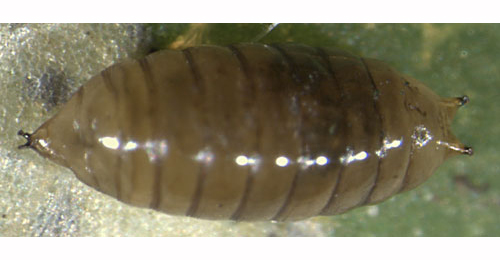|
||||||
|
Chromatomyia
periclymeni (de Meijere, 1924) Phytomyza
periclymeni de Meijere, 1924. Tijdschr. Ent. 67:
145 |
|||||||||||||||||||||||||||||||||||
|
Leaf-miner: Mine star shaped when small, sometimes with a longer linear section, later an irregular brownish blotch. Pupation internal (Spencer, 1976: 466). Mine not associated with the midrib, stellate, with a large number of short upper-surface corridors. The mine looks greyish and is inconspicuous. Frass in discrete grains. One, sometimes two larvae in a mine. Pupation within the mine (Bladmineerders van Europa). Forms an upper surface mine which is normally blotchy. The young mine is stellate. The initial mine is purple in colour - turning brown as it ages (British leafminers). Larva: The larvae of flies are leg-less maggots without a head capsule (see examples). They never have thoracic or abdominal legs. They do not have chewing mouthparts, although they do have a characteristic cephalo-pharyngeal skeleton (see examples), usually visible internally through the body wall. The larva is described by de Meijere (1926 and 1937) and Griffiths (1974). Puparium: The puparia of flies are formed within the hardened last larval skin or puparium and as a result sheaths enclosing head appendages, wings and legs are not visible externally (see examples). Yellowish-brown; posterior spiracles on short projections, each with about 20 bulbs (Spencer, 1976: 466). The anterior spiracles of the yellow-brown puparium penetrate the plant epidermis (Bladmineerders van Europa).
Hosts in Great Britain and Ireland:
|
|||||||||||||||||||||||||||||||||||

